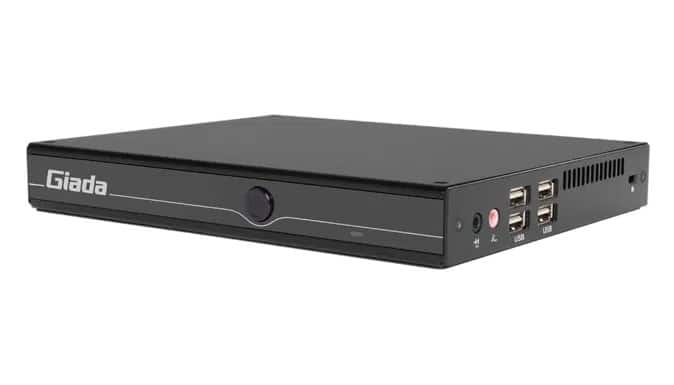
What You Need From a Digital Signage System
Posted on February 1, 2024
With the release of smaller computers and more powerful video interfaces, digital signage has also evolved. Let’s take a look at what features are needed for a PC to power digital signage solutions.
Features Required in a Digital Signage Computer
Small Form Factor
Embedded computers generally tend to be small, but for digital signage, nothing but the slimmest systems would do. This is because these computers are meant to be inconspicuous, powering HD displays without detracting from the existing decor.
Achieving this isn’t just a question of miniaturizing the chassis; the components need to be well-selected too. Our partner Giada, for example, has several carefully designed systems that have a small footprint without sacrificing performance.
Fanless Cooling
Traditional desktop computers use fans to cool their systems. While this approach is effective, it is also noisy, not to mention fault-prone and inefficient. Fan-based cooling systems also draw too much power, though that is more of a concern with large-scale industrial setups than digital signage.
The solution? Fanless cooling. By using a special chassis that has conducting fins on the exterior, a fanless cooling system is able to radiate out the heat without any active components involved.
Not only does this eliminate the noise, but it also removes the possibility of mechanical breakdowns requiring frequent repairs, as the fans can get jammed and serve as an intake of dust and other debris.
HDMI and DisplayPort Support
The key feature of a digital signage system is the ability to drive connected displays with high-definition audio-visual feeds. And for that, the computer needs to support the relevant standards. HDMI is the most common display interface used for carrying quality multimedia content to compatible screens. Capable of transmitting high-fidelity videos, it is great for advertisement boards and their like.
But HDMI is primarily a standard meant for televisions and domestic usage. For driving multiple displays from the same system, you need DisplayPort. This lets you deploy multiple screens cost-efficiently in commercial settings.
Graphics Processing
This one might come as a surprise, but in order to smoothly run 4K videos on high-resolution displays, the embedded PC needs to have strong graphics processing capabilities.
The good news is that integrated graphics have finally reached the point where they can handle the heavy lifting on their own. Recent releases from both AMD and Intel have turned integrated graphics into an efficient GPU of its own, letting the PC handle graphics-intensive tasks with ease.
This allows you to build energy-efficient PCs that can run digital signage for long hours without any stuttering. But for systems meant to run entire daisy chains of displays, a discrete GPU is a must. While this pushes up the cost and energy requirements of the PC, it is actually more cost-efficient for large advertising setups as you don’t have to get a separate computer for every screen.
Digital Signage Applications
Advertising
The most common use of digital signage systems is to deploy digital billboards for advertising products and services. These can range from overhead displays to wall-mounted panels scattered around a showroom.
As these displays are not meant to be interactive, it is easy to run multiple screens through a single digital signage system.
Smart Kiosks
Freestanding kiosks can also be considered a form of digital signage. The requirements for such a computer are slightly different from standard digital billboards, as you want customers to be able to interact with it.
This makes small, efficient digital signage systems best suited for powering smart kiosks. This keeps the costs low without impacting performance.
Education
With visual aids being integrated into learning, digital signage systems have found a new niche in the education sector. Whether paired with a projector or simply a large display, a digital signage system can be used in lessons with presentations and video content.
Using a standard desktop PC for this purpose will prove cumbersome, not to mention too expensive when considering the amount needed to implement in scale. Digital
signage systems, on the other hand, are already designed to smoothly play video content and do it efficiently.
What Should You Keep in Mind When Getting a Digital Signage System?
On the surface, digital signage seems like the easiest scenario for an embedded PC. But contrary to what you might expect, not just any computer will work well for digital signage.
First and foremost, you must look for PCs with multiple video interface ports (HDMI or DisplayPort). After that look for fanless cooling and a slim design so that it can be installed easily in any setting.
Of course, you don’t have to manually check off all these features if you are shopping from Global American, as we offer a variety of embedded computers specialized for digital signage solutions. You can choose from this catalog or get a board customized for your needs by our experts.
